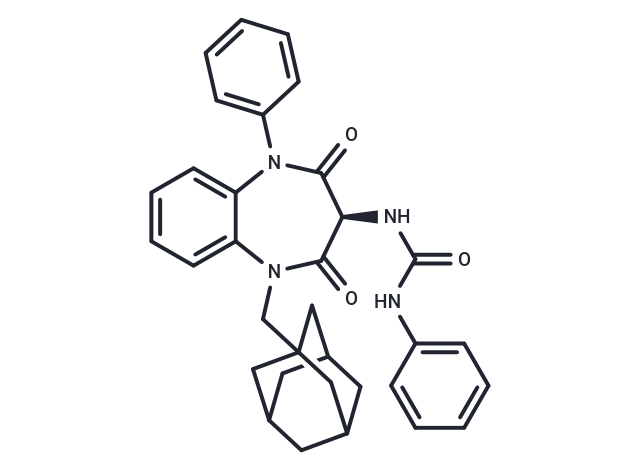
GV-150013X
CAS No. 151386-96-8
GV-150013X( —— )
Catalog No. M34276 CAS No. 151386-96-8
GV-150013X ((S)-1-(1-(adamantan-1-ylmethyl)-2,4-dioxo-5-phenyl-2,3,4,5-tetrahydro-1H-benzo[b][1,4]diazepin-3-yl)-3-phenylurea) is a potent CCKB antiagonist, pKi= 9.02.
Purity : >98% (HPLC)
 COA
COA
 Datasheet
Datasheet
 HNMR
HNMR
 HPLC
HPLC
 MSDS
MSDS
 Handing Instructions
Handing Instructions
| Size | Price / USD | Stock | Quantity |
| 2MG | 299 | Get Quote |


|
| 5MG | 454 | Get Quote |


|
| 10MG | 621 | Get Quote |


|
| 25MG | 911 | Get Quote |


|
| 50MG | 1224 | Get Quote |


|
| 100MG | 1575 | Get Quote |


|
| 500MG | Get Quote | Get Quote |


|
| 1G | Get Quote | Get Quote |


|
Biological Information
-
Product NameGV-150013X
-
NoteResearch use only, not for human use.
-
Brief DescriptionGV-150013X ((S)-1-(1-(adamantan-1-ylmethyl)-2,4-dioxo-5-phenyl-2,3,4,5-tetrahydro-1H-benzo[b][1,4]diazepin-3-yl)-3-phenylurea) is a potent CCKB antiagonist, pKi= 9.02.
-
DescriptionGV-150013X ((S)-1-(1-(adamantan-1-ylmethyl)-2,4-dioxo-5-phenyl-2,3,4,5-tetrahydro-1H-benzo[b][1,4]diazepin-3-yl)-3-phenylurea) is a potent CCKB antiagonist, pKi= 9.02.
-
In Vitro——
-
In Vivo——
-
Synonyms——
-
PathwayGPCR/G Protein
-
TargetCholecystokinin Receptor
-
Recptorcholecystokinin
-
Research Area——
-
Indication——
Chemical Information
-
CAS Number151386-96-8
-
Formula Weight534.65
-
Molecular FormulaC33H34N4O3
-
Purity>98% (HPLC)
-
Solubility——
-
SMILESC(C12CC3CC(C1)CC(C2)C3)N4C=5C(N(C(=O)[C@@H](NC(NC6=CC=CC=C6)=O)C4=O)C7=CC=CC=C7)=CC=CC5
-
Chemical Name——
Shipping & Storage Information
-
Storage(-20℃)
-
ShippingWith Ice Pack
-
Stability≥ 2 years
Reference
molnova catalog



related products
-
GI 181771
GI 181771 is an agonist of the cholecystokinin 1 receptor. GI 181771 can be used in studies about obesity.
-
Ceruletide
Ceruletide is a potent agonist of cholecystokinin receptor and it also is a safe and effective cholecystokinetic agent. It has a direct spasmogenic effect on the gallbladder muscle and bile ducts.Ceruletide is same as biologically and chemically to the human gastrointestinal hormones cholecystokinin-pancreozymin (CCK) and gastrin II.
-
Methyl Linoleate
Methyl linoleate has antioxidant activity.



 Cart
Cart
 sales@molnova.com
sales@molnova.com


